|

 |
|
 |
| |
Salaries
Tax
Salaries Tax is charged on all income arising
in or derived from Hong Kong from any office (e.g. a directorship),
employment or pension. The total tax payable is restricted
to an amount not exceeding the standard rate of Salaries Tax
of the net total income (without allowances) of the individual
concerned. For the year of assessment 2003-04, the standard
rate was increased from 15% to 15.5%.
|
|
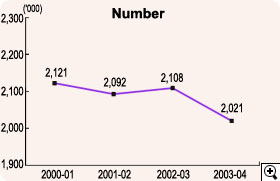 |
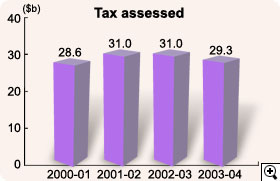
|
As compared with the previous
year, the number of assessments made during the year has slightly
dropped and 5.5% less tax was assessed (Figure 7).
Analyses of tax assessed and allowances granted in respect
of taxpayers at various income levels are provided in Schedules
5 and 6.
With the drop in the level of salaries,
there was a decrease of 5.1% in the number of standard rate
taxpayers, from 12,328 last year to 11,697 this year. These
taxpayers together contributed 20.2% of the Salaries Tax assessed,
compared to 21.5% last year (Figure 8).
Notification Requirements
of Employers
Apart from reporting commencements and cessations
of employments, employers are required to prepare annual returns
to report the emoluments of each of their employees. During
the year, 218,582 employers filed employer's returns with
the Department. |
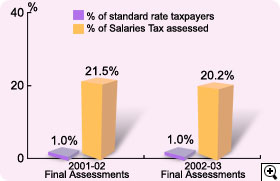
|
| The Department firmly believes
that continuous taxpayer education can help promoting voluntary
compliance by employers. Apart from disseminating information
on the IRD Homepage, the Department continues to hold e-Seminar
for employers this year. Information on completion of employer's
return, employer's obligation and answers to frequently asked
questions were uploaded to the IRD website. Employers can also
obtain information and specimens of employer's return through
the Fax-A-Form service. |
|
|
 |
|
 |
 |
|
 |
| |
Objections
A taxpayer who is aggrieved by an assessment made under the
Inland Revenue Ordinance may lodge an objection to the Commissioner.
A significant proportion of the objections received each year
arises from estimated assessments issued to taxpayers who
fail to lodge returns in time. An objection of this nature
must be supported by a completed return and, where applicable,
by supporting accounts. Most of these objections are settled
promptly by reference to the returns subsequently submitted.
Most of the other types of objections are also settled by
agreement between the taxpayer and the assessor. Only a small
percentage of objections are ultimately referred to the Commissioner
for determination. During the year, the Department processed
over 67,000 objections (Figure 12).
|
| |
2002-03 |
2003-04 |
| |
|
Number |
|
Number
|
| Awaiting settlement at the beginning of the year |
|
22,598 |
|
24,499 |
| Add: Received during the year |
|
79,548
 |
|
68,961
 |
| |
|
102,146 |
|
93,460 |
| Less: Disposed of
- |
Settled or withdrawn |
76,723 |
|
66,094 |
|
| Assessment confirmed |
482 |
|
540 |
|
| Assessment
reduced |
265 |
|
253 |
|
| Assessment
increased |
164 |
|
142 |
|
| Assessment
annulled |
13
 |
77,647
 |
13
 |
67,042
 |
| Awaiting settlement at the end of the year |
|
24,499
 |
|
26,418
 |
|
|
 |
|
 |
 |
|
 |
| |
Business
Registration
The Department aims to maintain an efficient business registration
system. Every person carrying on business in Hong Kong must
register the business and pay the required fee. Registered
businesses may renew their registration certificates either
annually or once every 3 years. Up to 31 March 2004, 9,200
businesses had taken the 3-year certificates.
As a budgetary measure for 2002-03, the
business registration fee was waived for a year with effect
from 1 April 2002. Following the expiration of the waiver
period on 31 March 2003, collection of business registration
fee was resumed on 1 April 2003 at the original fee scale
i.e. $2,000 for a certificate that is valid for one year and
$5,200 for one that is valid for 3 years. As before, registered
businesses and branches are also required to pay the levy
for the Protection of Wages on Insolvency Fund at $600 for
a 1-year certificate and $1,800 for a 3-year certificate. |
The special refund exercise
for businesses which had already paid registration fees for
2002-03 but were not required to renew their registration
certificates during the year was completed on 30 September
2003 as scheduled. For the whole exercise, the Department
issued 53,942 application forms to eligible businesses, of
which 13,925 had been returned. 12,186 successful applicants
were issued refunds totalling $14.48 million.
The resumption of business registration
fee collection had brought the number of new registrations
in 2003-04 down by 13,910, whereas the number of cancelled
registrations was 10,356 more than last year (Schedule
8). Although the total number of active registrations
still managed to record a growth of 10,837 for the year (Figure
15), there was a decrease of 4.2% in the number of
certificates issued. Total business registration fees collected
in the year was $1,233 million (Figure 16).
|
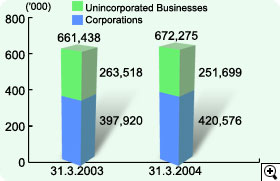
|
| |
2002-03 |
2003-04 |
Increase/Decrease |
| Number of certificates issued (Main and Branch) |
743,880 |
712,934 |
-4.2% |
| Fees (inclusive of penalties) ($m) |
127.7 |
1,233.3 |
865.8% |
Under the Business Registration
Ordinance, a small business with sales or receipts below a
specified limit ($10,000 for a business mainly deriving profits
from the sale of services or $30,000 for other businesses)
could apply for exemption from payment of the fee and levy.
The number of total exemptions granted during the year was
13,743, representing a significant increase of 64% from the
previous year.
Where an application for exemption is not
allowed, the business operator may appeal to the Administrative
Appeals Board. 11 appeals were received by the Board in 2003-04,
of which 3 were dismissed and 7 were subsequently withdrawn
by the appellant (Figure 17).
|
| |
|
Number |
| Awaiting hearing as at 1 April 2003 |
|
0 |
| Add : Lodged during the year |
|
11
 |
| |
|
11 |
| Less:
Disposed of - |
Appeal dismissed |
3 |
|
| Appeal withdrawn |
7
 |
10
 |
| Awaiting hearing as at 31 March 2004 |
|
1
 |
|
|
 |
|
 |
 |
|
 |
| |
| Stamp
Duty
Stamp Duty is charged on instruments effecting property and
stock transactions and leasing of property (Figure
18).
Both the property and stock markets remained
sluggish during the first half of 2003-04. Following the sharp
economic rebound towards the second half of the year, there
have been marked increase in both property and stock transactions.
The stamp duty collections from property and share transactions
increased by 20% and 95% respectively when compared with the
previous year.
Overall, there was a handsome increase of
51% in total stamp duty collections during the year (Figure
19 and Schedule
9). The number of documents stamped also increased
by 7.2% (Schedule
10). |
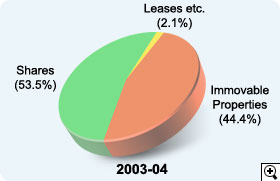
|
| |
2002-03
($m) |
2003-04
($m) |
Increase |
| Immovable Properties |
4,151 |
4,996 |
+20% |
| Shares |
3,088 |
6,019 |
+95% |
| Leases etc. |
219 |
230 |
+5% |
| Total |
7,458 |
11,245 |
+51% |
|
|
 |
|
 |
 |
|
 |
| |
Betting
Duty
Betting Duty is charged on bets made on totalisators at race
meetings conducted by the Hong Kong Jockey Club and on the
proceeds of lotteries conducted by the HKJC Lotteries Limited.
Effective from August 2003, betting duty is also payable on
the net stake receipts from the conduct of authorized betting
on football matches by the HKJC Football Betting Limited.
In 2003-04, the duty rate on Exotic Bets
on horse racing was increased from 19% to 20% (with effect
from 1 August 2003). The other rates of duty remained unchanged
(Figure 22). |
| |
|
Rate |
| Standard Bets |
win, place, double, quinella and
quinella place |
12% |
| Exotic Bets |
six up, treble, tierce,
trio, double trio and triple trio |
20% * |
| Lotteries |
|
25% |
| Football Betting |
|
50% ** |
| Note: |
* |
Rate
increased from 19% to 20% with effect from 1 August 2003. |
| |
** |
Duty rate on the
net stake receipts. |
|
|
|
| During the year, both the
racing attendance and bets on horse racing were on the decline
(Schedule
13), resulting in a drop of 4.8% in the duty
collected from horse racing. However, lotteries duty collection
increased by 13.2%, which, together with the duty from football
betting newly introduced in August 2003, accounted for an
increase of 6.5% in total betting duty collection in 2003-04
over that of the previous year (Figure 23). |
| |
2002-03
($m) |
2003-04
($m) |
Increase/Decrease |
| Horse Racing |
9,725.7 |
9,258.7 |
-4.8% |
| Lotteries |
1,195.0 |
1,352.9 |
+13.2% |
| Football Betting |
- |
1,024.3 |
- |
| Total |
10,920.7 |
11,635.9 |
+6.5% |
|
|
 |
|
 |
 |
|
 |
| |
Hotel
Accommodation Tax
Hotel Accommodation Tax is imposed on hotel and guest house
accommodation at the rate of 3% of the accommodation charges
paid by guests and is collected quarterly in arrears.
In 2003-04, the number of hotels, boarding
houses and taxable rooms remained almost unchanged (Figure
24). However, average room occupancy rate dropped
by 16.7% (Figure 25) due to the outbreak
of SARS in early 2003. A decrease in room charges (Schedule
14) was recorded. Total tax collected in the
year was 22.6% less than that of the previous year (Figure
26). |
|
| |
2002-03 |
2003-04 |
Increase |
| Hotels and Boarding Houses |
161 |
162 |
+0.6% |
| Taxable Rooms |
39,101 |
39,135 |
+0.1% |
| Exempted Rooms |
5,315 |
5,484 |
+3.2% |
|
| |
| |
2002-03 |
2003-04 |
Decrease |
| Room Days |
11,057,669 |
8,553,005 |
-22.7% |
| Occupancy Rate |
83.9% |
67.2% |
-16.7% |
|
|
|
 |
|
 |
 |
|
 |
| |
Tax
Reserve Certificates
There are two sets of circumstances under which Tax Reserve
Certificates are purchased.
The first applies to taxpayers who wish
to save for the payment of their future tax liabilities. Two
service schemes are offered to these taxpayers: the "Electronic
Tax Reserve Certificates Scheme" for all taxpayers and the
"Save-As-You-Earn" (SAYE) Scheme for civil servants and civil
service pensioners. Under the Electronic Tax Reserve Certificates
Scheme, certificates can be purchased using various electronic
means, i.e. by bank autopay, telephone, the Internet, public
information kiosk and bank ATM. Under the SAYE Scheme, certificates
are purchased by civil servants and civil service pensioners
through monthly deductions from their salaries/pensions. Interest
is payable on the certificates when they are redeemed for
settlement of tax liabilities, based on the interest rate
prevailing at the time of purchase, for a maximum period of
36 months from the date of purchase.
In 2003-04, a promotion campaign launched
by a payment service provider was well received by the public,
resulting in a substantial jump in the number of certificates
sold under the Electronic Tax Reserve Certificates Scheme.
While there was an increase of 76.8% in the number of certificates
sold under the Electronic Tax Reserve Certificates Scheme,
there was a slight drop of 3.6% in the sale of certificate
under the SAYE Scheme (Schedule
15). The total amount involved decreased by 4.9%
(Figure 27). |
|
|
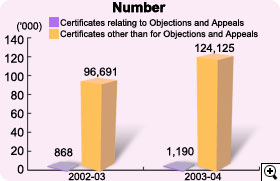 |
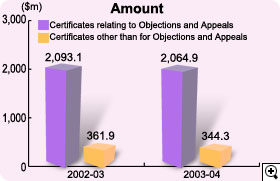
|
| The second situation applies to taxpayers
who object to tax assessments and are required to purchase Tax
Reserve Certificates in respect of the tax in dispute. Such
certificates are used to settle any tax found payable upon the
finalization of the objection or appeal. Interest is only payable
on the amount, if any, subsequently required to be repaid to
the taxpayer, and is computed at floating rates ruling over
the tenure of the certificate. |
|
|
 |
|
 |
|

